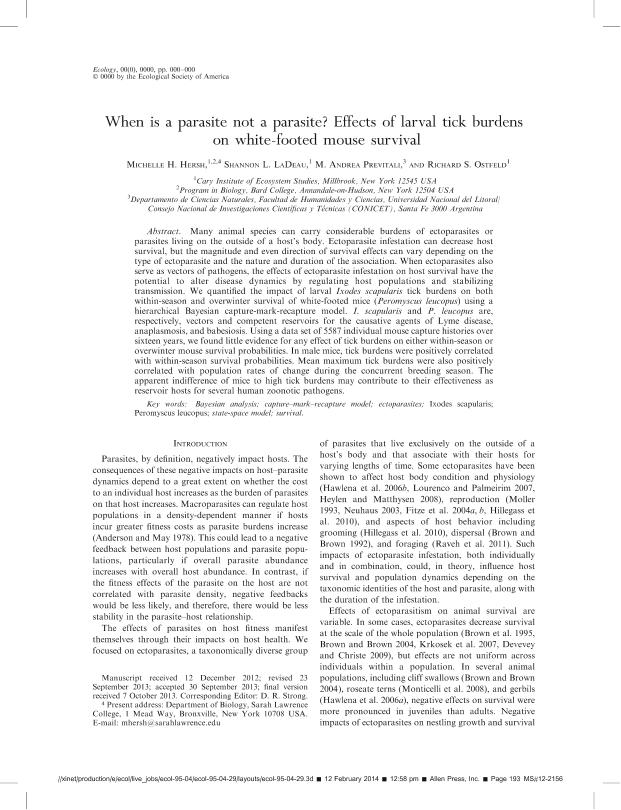Mostrar el registro sencillo del ítem
dc.contributor.author
Hersh, Michelle H.
dc.contributor.author
LaDeau, Shannon L.
dc.contributor.author
Previtali, Maria Andrea

dc.contributor.author
Ostfeld, Richard S.
dc.date.available
2017-12-22T21:01:12Z
dc.date.issued
2014-05
dc.identifier.citation
Hersh, Michelle H.; LaDeau, Shannon L.; Previtali, Maria Andrea; Ostfeld, Richard S.; When is a parasite not a parasite? Effects of larval tick burdens on white-footed mouse survival; Ecological Society of America; Ecology; 95; 5; 5-2014; 1360-1369
dc.identifier.issn
0012-9658
dc.identifier.uri
http://hdl.handle.net/11336/31444
dc.description.abstract
Many animal species can carry considerable burdens of ectoparasites: parasites living on the outside of a host's body. Ectoparasite infestation can decrease host survival, but the magnitude and even direction of survival effects can vary depending on the type of ectoparasite and the nature and duration of the association. When ectoparasites also serve as vectors of pathogens, the effects of ectoparasite infestation on host survival have the potential to alter disease dynamics by regulating host populations and stabilizing transmission. We quantified the impact of larval Ixodes scapularis tick burdens on both within-season and overwinter survival of white-footed mice (Peromyscus leucopus) using a hierarchical Bayesian capture-mark-recapture model. I. scapularis and P. leucopus are, respectively, vectors and competent reservoirs for the causative agents of Lyme disease, anaplasmosis, and babesiosis. Using a data set of 5587 individual mouse capture histories over sixteen years, we found little evidence for any effect of tick burdens on either within-season or overwinter mouse survival probabilities. In male mice, tick burdens were positively correlated with within-season survival probabilities. Mean maximum tick burdens were also positively correlated with population rates of change during the concurrent breeding season. The apparent indifference of mice to high tick burdens may contribute to their effectiveness as reservoir hosts for several human zoonotic pathogens.
dc.format
application/pdf
dc.language.iso
eng
dc.publisher
Ecological Society of America

dc.rights
info:eu-repo/semantics/openAccess
dc.rights.uri
https://creativecommons.org/licenses/by-nc-nd/2.5/ar/
dc.subject
Bayesian Analysis
dc.subject
Capture-Mark-Recapture Model
dc.subject
Ectoparasites
dc.subject
Ixodes Scapularis
dc.subject
Peromyscus Leucopus
dc.subject
State-Space Model
dc.subject
Survival
dc.subject.classification
Otras Ciencias Biológicas

dc.subject.classification
Ciencias Biológicas

dc.subject.classification
CIENCIAS NATURALES Y EXACTAS

dc.title
When is a parasite not a parasite? Effects of larval tick burdens on white-footed mouse survival
dc.type
info:eu-repo/semantics/article
dc.type
info:ar-repo/semantics/artículo
dc.type
info:eu-repo/semantics/publishedVersion
dc.date.updated
2017-12-21T14:06:24Z
dc.identifier.eissn
1939-9170
dc.journal.volume
95
dc.journal.number
5
dc.journal.pagination
1360-1369
dc.journal.pais
Estados Unidos

dc.journal.ciudad
Washington, DC
dc.description.fil
Fil: Hersh, Michelle H.. Cary Institute of Ecosystem Studies; Estados Unidos. Bard College. Program in Biology; Estados Unidos. Sarah Lawrence College; Estados Unidos
dc.description.fil
Fil: LaDeau, Shannon L.. Cary Institute of Ecosystem Studies; Estados Unidos
dc.description.fil
Fil: Previtali, Maria Andrea. Universidad Nacional del Litoral. Facultad de Humanidades y Ciencias. Departamento de Ciencias Naturales; Argentina. Consejo Nacional de Investigaciones Científicas y Técnicas. Centro Científico Tecnológico Conicet - Santa Fe; Argentina
dc.description.fil
Fil: Ostfeld, Richard S.. Cary Institute of Ecosystem Studies; Estados Unidos
dc.journal.title
Ecology

dc.relation.alternativeid
info:eu-repo/semantics/altIdentifier/doi/http://dx.doi.org/10.1890/12-2156.1
dc.relation.alternativeid
info:eu-repo/semantics/altIdentifier/url/http://onlinelibrary.wiley.com/doi/10.1890/12-2156.1/abstract
Archivos asociados
